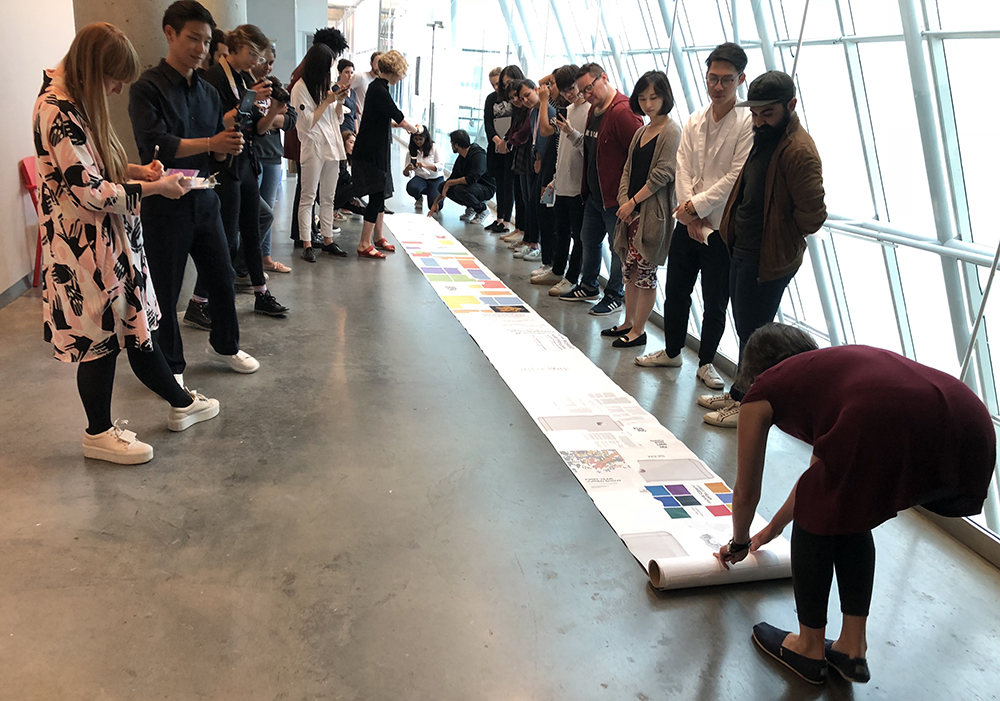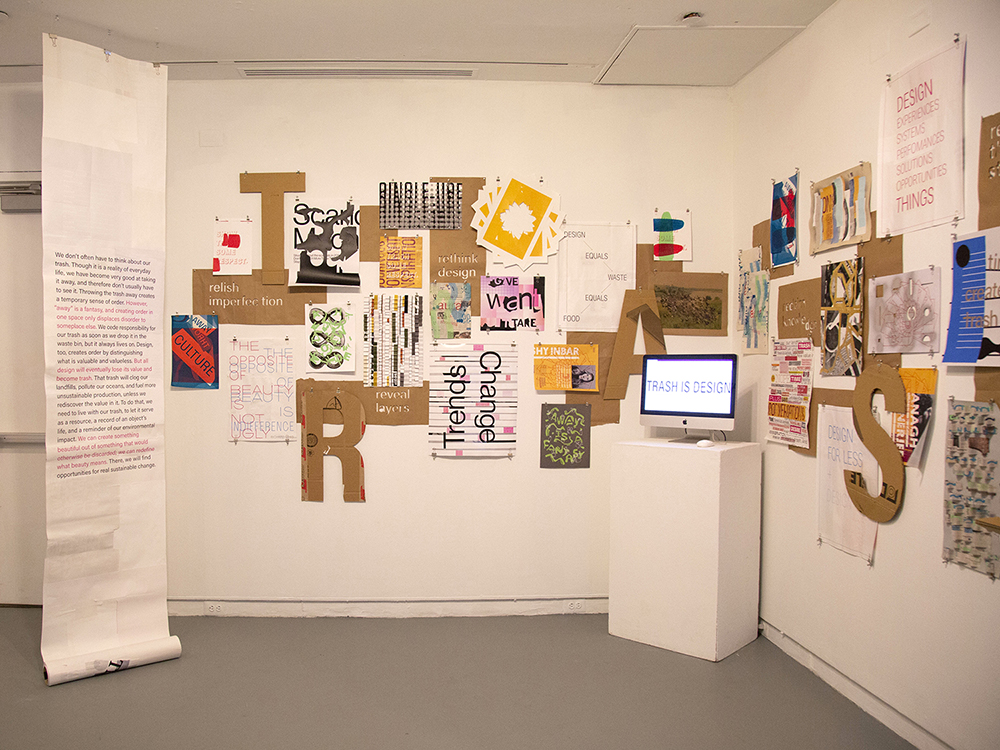On Remaking Trash into Design
Katie Mancher
As a graphic designer, I am not going to invent more efficient technology or change government policy on carbon emissions. Still, designers serve as translators between the organizations that shape our world and the people that live in it. We therefore have the power to do much more than constantly be making new things wrapped in a slick, modern aesthetic. Rather, we can define what sustainable change should look like and communicate the hidden consequences of our consumption.
I believe this goes beyond the popular aesthetic of sustainable design, a term that encompasses a range of products from the genuinely innovative to “green-washed”1 marketing devices. “Green” products may include those that use less plastic or material overall, are organic, compostable, made from recycled materials, chemical-free, multi-use, reusable, or, are literally green or “natural”-colored. Regardless of what benefit the product actually does or doesn’t have for the environment, it will almost always look a certain way, and communicate a certain story to consumers: that we can keep making and consuming in the same way we always have, but be a little “less bad”2 about it.

Non-Value to Value
Instead, graphic designers—as well as consumers—must confront the relationship between the things we produce and what we waste.
One obstacle to tackling the problem of waste is that we don’t like to look at it. No one wants to keep trash around for that long (justifiably, as it is linked to disease and environmental hazards, along with being an eyesore), so sophisticated systems have been created to take it away. Municipal sanitation is a feat of developed societies, and has allowed for the standard of living we enjoy today.
A consequence, however, of trash collection is that we don’t have to think much about the trash we make. Throwing away the trash creates a temporary condition of cleanliness and order (the same may be said of designing). However, “away” is a fantasy. The creation of order in one space—on a desk, in a home, in a city—only displaces the disorder to someplace else. We give up responsibility for our trash as soon as we leave the bin on the curb, but the trash itself invariably lives on.
Trash is also hard to think about in relation to design because it means associating the thing we give meaning with something that is worthless. However, these are two sides of a coin. The anthropologist Michael Thompson believes it is only when something has no value—when it becomes rubbish—that it can regain value and become durable.3 As designers, we can apply this principle to the waste we generate as a byproduct of our practice and as outcome of our practice. Once we break our attachment to the thing in one context, it can be reintegrated into design and gain new meaning.
Perhaps one step towards change is to truly live with our trash, to let it serve as a resource and as a visible reminder of our environmental impact. Both trash and design can cause harm, but both can create value. We can make something beautiful out of what would otherwise be discarded; we can redefine what beauty means. There, we can find opportunities for real sustainable change.
Embodied History
Repurposed materials carry an added meaning from their past life. This is at least part of the reason why artists and designers have experimented with found materials. In the early twentieth century, Cubists and Dadaists began to work with collage and photomontage and in doing so they referenced and commented on the relatively new technologies of mass media and mechanical reproduction. This technique filtered into graphic design. Through the end of the twentieth century it continued to be explored in unique ways in pop art and punk aesthetics.

Photomontage by Hannah Höch, 1919, and punk show flyer, 1987
Now that the production of design has moved into an almost entirely digital space, how do we maintain the connection to the materiality of the things we produce, let alone the the people and craft that went into making it?
We can look to the ecological concept of embodied energy, which accounts for all energy used during the life of an object, including its material extraction, processing, manufacturing, shipping, use and end-of-life. Understanding the embodied energy is an important factor when determining how to make a product more energy-efficient and sustainable. I propose another quality designers should consider: embodied history. How does the object communicate where it came from? What are the lives it has lived?
Trash is Design
I began to explore this approach when I was trying to visualize the amount of trash we dispose of and never see in totality. I collected paper waste generated in one weekend from the graphic design MFA studio the recycling bins (an impressive amount despite being in the digital age). I “reassembled” this paper by gluing it together into a new roll and then printed posters with sustainable design slogans on the blank side. Each individual poster was made up of several used pieces of paper combined in an irregular pattern. The printed graphics on the back were faintly perceptible. I kept the poster designs simple, allowing this “history” of the poster’s construction to provide the real interest in each piece. The result was not attractive in the way that we expect modern design to be. “Good design” is considered to be controlled and reproducible, looking the same in every place it appears. In contrast, these posters were irregular and dictated by the paper’s unique form, so each one was unique. Their beauty lies in their sustainable use of materials, and the message the material, itself, conveys.
I then developed designs and strategies that allowed for printing directly on already-printed graphics. I also minimized my waste by limiting my color palette, printing patterns instead of solids, and layering text. I explored how a message was affected by the material or image it was printed on, and also speculated about products that could utilize this technique to describe the full lifecycle of a material and object.


Instead of inventing new forms, I looked for design waste whose images and messages I could recontextualize. Starting again from the recycling and trash bins of the studio, I picked up scraps of people’s projects that perhaps no longer held value for them. I scanned paper trimmings and let these images dictate a new composition. I used vinyl scraps to form typography and make a stencil to be screen printed. I found fragments of imagery that contained beautiful compositions in themselves that could serve as a base for a poster or publication. Additionally, I looked to products of graphic design on the extreme end of commerce, such as catalogs and circulars, and collaged their messages (BUY SALE NOW!) to serve my own meanings.

*Trash is Design* thesis project exhibition
Many of these experiments did not come out perfectly, or how I envisioned they might. In one experiment, I pulped old projects to recycle into new paper. Though lovely as its own object, the paper was extremely thin and delicate and I was afraid to do anything with it. When I attempted to screen print on used paper that was slightly warped, the paper didn’t align well and stuck to the screen. When overprinting on already-designed paper, I found I had to select the substrate carefully so that it wouldn’t interfere too much with my own design. This project has been a constant learning process, as I discovered that conventional design techniques don’t work the same when a reused material is introduced. I have had to develop my own methods for working around (or embracing) the unexpected results that may happen.
Re-Creating a Better World
Making design out of trash—and finding real sustainable solutions—requires inspiration and a determination. As design students about to make your mark on the world, I hope you will take on this challenge. So here are some ideas to think about to help you see your work and the world in a new way:
- See your trash. Count it, arrange it, do what designers do to make information understandable. What can you learn from your trash about who you are, about your process and habits, and where there is room for change?
- Embrace process. Share your process. Do things slowly and carefully. Figure out how something is made. Then teach someone else how to make it.
- Give up some control. Many of the forces we must contend with as designers are out of our hands. Rather than trying to bend these forces to our will (and creating many more problems), we can embrace the variability and let that shape our design.
- Don’t forget the context in which we make. Design is shaped by intermingled social, political, and economic conditions. There is a reason things look the way they do. There is a reason humans are decimating the environment. There is a reason we are okay with what we make becoming trash. None of these are natural or predetermined, which means the way we do things can change.
- Remember that design is a living thing. As designers, we are responsible for a design’s entire life: how it is created, used, and disposed of, and the impact that it will leave behind.
Notes
-
Greenwashing refers to the practice of companies promoting minor sustainable products or policies in order to mask greater environmental abuses, or making misleading claims about the environmental benefits of a product. ↩
-
Michael Braungart and William McDonough, Cradle to Cradle: Remaking the Way We Make Things (New York: Farrar, Straus and Giroux, 2010), 45. ↩
-
Michael Thompson, Rubbish Theory: The Creation and Destruction of Value. 2nd ed. (London: Pluto Press, 2017), 2-3. ↩